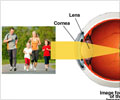New insights on why some corneal transplants fail, why some patients skip their glaucoma medications, and why preventing infections after LASIK is a growing concern
New insights on why some corneal transplants fail, why some patients skip their glaucoma medications, and why preventing infections after LASIK is a growing concern are some of the major topics covered in the June issue of Ophthalmology, the journal of the American Academy of Ophthalmology.
Patients at Higher Risk for Corneal Transplant FailureResearchers analyzed data for 1,090 participants in the Cornea Donor Study (CDS), a multicenter, controlled clinical trial, to find factors linked with corneal transplant failure. The failure rate was about four times higher in patients diagnosed with corneal edema (swelling) associated with either intraocular lens (IOL) implants or no natural lens following cataract removal, than in patients diagnosed with Fuchs' dystrophy, a disorder of the corneal endothelial layer. Also, failure rates were substantially higher for glaucoma patients treated surgically, with medications, or both. These results, reported by Alan Sugar, M.D., for the CDS Investigator Group, were part of a five-year study funded by the National Eye Institute and coordinated by the Jaeb Center for Health Research, Tampa, Florida.
The 27 percent of patients diagnosed with IOL-associated corneal edema whose transplants failed may have shared an underlying problem: an abnormal reaction to cataract surgery and/or IOLs that negatively impacted the cornea in some way. (The vast majority of patients who have cataract-IOL surgery have no such reaction.) When these patients received new corneas, their underlying problem remained and compromised the transplant, the researchers suggest. In contrast, Fuchs' dystrophy patients had only a seven percent failure rate, including those who had IOLs. The failure rate for participants who did not have glaucoma was 11 percent versus failure rates of 20 percent, 29 percent and 58 percent for glaucoma patients treated with medications alone, surgery alone, or both, respectively.
Why do Some Glaucoma Patients Skip Their Medications?Motivating patients with chronic illness to follow treatment plans is a challenge for physicians, as ophthalmologists who treat people with glaucoma can attest. Studies covering a range of chronic diseases consistently show that only about 70 percent of prescribed medications are taken. With glaucoma, patients may not take their eyedrops because they often have no pain and few symptoms and because treatment benefits are apparent over years rather than immediately. To learn more about adherence, a team of researchers from Johns Hopkins and University of Pennsylvania Schools of Medicine gave glaucoma patients a prostaglandin eyedrop medication at no cost and monitored use with an electronic device.
"Eighty-six of our 196 study patients (44 percent) took their medication less than 75 percent of the time. A combined analysis found the most important factors were age (younger and older patients were less adherent), African-American ethnicity, and poorer overall health," said lead researcher David S. Friedman, MD, of Johns Hopkins Wilmer Eye Institute. Other factors included whether the patient was knowledgeable about glaucoma, understood how treatment worked, and expressed concern that it would help preserve his or her vision. These findings add to and are consistent with previous reports. Some research has suggested that the ethnicity of the health professional may affect quality of care for African-Americans, but that effect was not detected here. Dr. Friedman recommended further research to explore lower adherence among African-Americans.
Beating Bacteria to Prevent Post-LASIK InfectionsSince bacteria mutate frequently and become resistant to new antibiotics, ophthalmic researchers are on a continuous quest to identify the worst offenders and best treatments. Infections occur rarely in LASIK patients, but data show rates are slowly rising. A recent study at Yonsei University College of Medicine, South Korea, evaluated infection risk in 105 patients using eye surface (conjunctiva) swabs taken immediately before LASIK or similar refractive surgery to measure preexisting bacteria.
Coagulase-negative staphylococci (CNS) was found in 84.9 percent of the cultures grown from the swab samples, and 31.4 percent was antibiotic (methicillin)-resistant. In other studies over the past decade the incidence of resistant CNS was less than two percent. This significant increase suggests that resistant strains are spreading through community contact and not only through surgical units, the researchers said. The community-based spread of infections like CNS and methicillin-resistant staphylococcus aureus (MRSA) is raising concern world-wide, including in the United States. Lead researcher Kyoung Yul Seo, M.D., and colleagues used five fluroquinolone antibiotics (three newer generation and two older) to treat the bacteria in the culture samples. The most effective was the newest fluroquinolone approved by the U.S. Food and Drug administration. Dr. Seo thinks using the newer fluroquinolones as initial treatment may limit bacterias' ability to generate resistant mutations.
Advertisement
Advertisement
RAS















